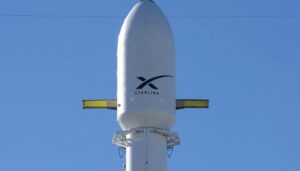
The launch of a Falcon 9 rocket with the next batch of 54 mini-satellites to replenish the orbital constellation of the Starlink system’s global Internet coverage network, scheduled for Friday, was canceled 40 seconds before liftoff, developer SpaceX said.
No reason was reported. The backup launch date is Saturday, July 15.
This is Starlink’s 94th internet satellite launch since May 2019 and its 25th since the beginning of this year. SpaceX has already put more than 4,700 of these satellites into orbit. Some of them failed or went out of orbit. More than 4.4 thousand devices remain in orbit in working condition.
The first reusable stage of the launch vehicle, which is being used for the 16th time, will have to make a controlled vertical landing after separation on the offshore drone platform A Shortfall of Gravitas, located 642 kilometers from the spaceport in the Atlantic.

The Falcon 9 rocket will launch into orbit on Friday with another batch of 54 mini-satellites to replenish the orbital constellation of the Starlink system’s global Internet coverage network, developer SpaceX said.
The launch will take place from Launch Complex 40 at the U.S. Space Force base at Cape Canaveral in Florida on Sunday at 00:40 U.S. East Coast time (7:40 a.m. QST).
This is Starlink’s 94th internet satellite launch since May 2019 and its 25th since the beginning of this year. SpaceX has already put into orbit more than 4.7 thousand such satellites. Some of them failed or went out of orbit. More than 4.4 thousand devices remain in orbit in working condition.
The first reusable stage of the launch vehicle, which is being used for the 16th time, will have to make a controlled vertical landing on the offshore drone platform A Shortfall of Gravitas, located in the Atlantic.

A Falcon 9 rocket on Sunday successfully launched another batch of 22 mini-satellites into orbit to add to the orbital constellation of the Starlink global Internet coverage system, the developer SpaceX said.
“The launch of 22 Starlink satellites has been confirmed,” the statement said.
The launch took place from Launch Complex 40 at U.S. Space Force Base at Cape Canaveral, Florida, at 08:20 U.S. East Coast time (3:20 p.m. QT).
It was the 88th launch of Internet satellites since May 2019 as part of the Starlink project and the 19th since the beginning of this year. Including the current launch, SpaceX has already put into orbit more than 4.5 thousand such satellites. Some of them have failed or fallen out of orbit. More than 4,200 apparatuses remain in orbit in working condition.
At the same time, the first reusable stage of the launch vehicle, which was used to launch for the third time, in about nine minutes after the launch made a controlled vertical landing on the offshore platform-drone in the Atlantic.

The Falcon 9 rocket on Friday successfully injected into orbit another batch of 52 mini-satellites to replenish the orbital constellation of the Starlink global Internet coverage network, the developer SpaceX said.
“The launch of the 52 Starlink satellites has been confirmed,” the statement said.
The launch took place from the SLC-4E launch pad at U.S. Space Force Base Vandenberg in California at 12:26 p.m. U.S. Pacific Coast Time.
It was the 78th launch of Internet satellites since May 2019 as part of the Starlink project and the ninth since the beginning of this year. Including the current launch, SpaceX has already put more than 4,100 such satellites into orbit. Some of them have failed or fallen out of orbit. More than 3.8 thousand devices remain in orbit in working condition.
As part of the launch, the first reusable stage launch vehicle Falcon 9, which was used for the eighth time, about nine minutes after launch, made a controlled vertical landing on a floating drone platform Of Course I Still Love You, which was located in the Pacific Ocean, 670 km from the base.
The company is currently the largest satellite operator in the world. The Starlink Internet network is available to users in 50 countries, including North America, Europe, the Far East and Australia. According to the Pentagon, the services of these satellites are also actively used by the U.S. military.
In the future SpaceX plans to deploy an orbital constellation of 12 thousand spacecraft (and in the future – from 30 thousand) to create a full-scale network, which will provide residents of the earth broadband Internet access anywhere in the world. The total amount of investments in implementation of the project is estimated at $10 billion.

A Falcon 9 rocket on Sunday successfully injected another batch of 55 mini-satellites into orbit to replenish the orbital constellation of the Starlink global Internet coverage network, the developer SpaceX said.
“The launch of the 55 Starlink satellites has been confirmed,” the statement said.
The launch took place from the 40th launch pad of the U.S. Space Force Base at Cape Canaveral in Florida at 00:10 U.S. East Coast time (07:10 Kiev time).
About 1 hour and 4 minutes after the launch, the Starlink satellites separated from its second stage and entered a standard orbit.
This is the 73rd launch of a group of Internet satellites into orbit since May 2019 as part of the Starlink project and the fifth this year.
Including the current launch, SpaceX has already put more than 3,900 Starlink satellites into orbit. Some of them have malfunctioned or fallen out of orbit. Over 3.6 thousand devices remain in orbit in working condition.
Meanwhile, the first reusable stage rocket carrier rocket, which was used for the 12th time, about nine minutes after the launch made a vertical controlled landing on the sea platform drone A Shortfall of Gravitas, which was in the Atlantic at about 660 km from the launch pad.
In addition, a special rescue SpaceX vessel was to lift two fairing flaps of the rocket head part out of the water, which, after separation, descended by parachute. The re-use of the fairing saves SpaceX up to $6 million for its rocket launches.
The company is currently the largest satellite operator in the world. Internet from Starlink is available to users in 47 countries, including North America, Europe, the Far East and Australia. According to the Pentagon, the services of these satellites are also actively used by the U.S. military.
In the future SpaceX plans to deploy an orbital constellation of 12 thousand spacecraft (and in the future – from 30 thousand) to create a full-scale network, which will provide residents of the earth broadband Internet access anywhere in the world. The total amount of investments in implementation of the project is estimated at $10 billion.

Ukrzaliznytsia has successfully completed testing Starlink-based wi-fi on Intercity trains, head of the company Alexander Kamyshyn said in Telegram on Tuesday.
“Test results: availability on the route 97%, speeds up to 100 Mbps. Vice Prime Minister Kubrakov has set us the task now to deploy the pilot to all Intercity trains. By the end of the year the task will be accomplished”, – noted the head of the railway operator.
According to his words, the train was equipped with Starlinks “by partisan methods” and tested on different routes for more than 100 days.
Kamyshin said that he called from the train via video link to the Deputy Prime Minister Mikhail Fedorov and thanked him for his support.
In turn, Fedorov said that Ukrzaliznytsia has already received 450 Starlink terminals and by the end of the year will receive another part, in particular, from the batch that Germany will provide Ukraine in early February.
“Thousands of Starlink we will receive from Germany, I think, in early February,” said the deputy prime minister.
As reported, the last batch – 8 thousand terminals – was helped to Ukraine by Poland. More than 30 thousand Starlink terminals have already been deployed in the country.